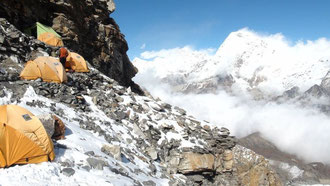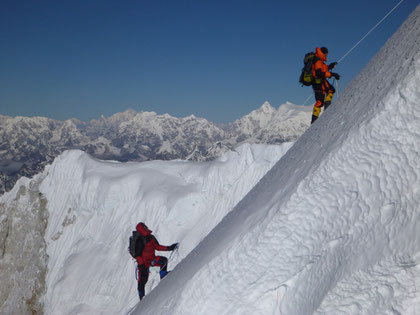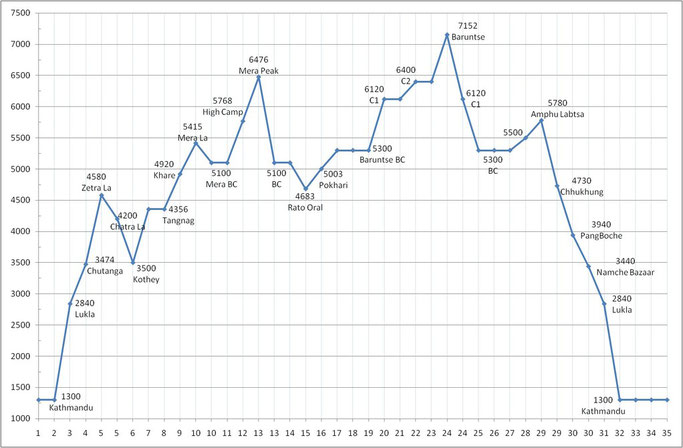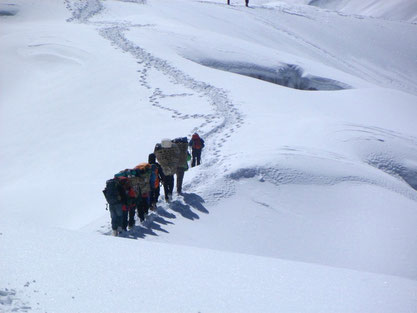Baruntse & Mera Peak - Nepal
Summited Mera Peak North 25 october 2011 at 06:40
Summited Baruntse 03 november 2011 at 11:30
Time difference with Belgium
summer +3:45
winter +4:45
The mountains
Mera Peak
This mountain lies in the Sagarmatha region of Nepal. At 6,476 metres (21,247 ft) and it is classified as a trekking peak and more specific the highest trekking peak.
The first ascent was on May 20, 1953 by Col. Jimmy Roberts and Sen Tenzing. The region was first explored extensively by British expeditions in the early 50s before and after the ascent of Everest. Members of those teams included Edmund Hillary, Eric Shipton and George Lowe.
The view from the summit is one of the finest in the Himalaya with five 8,000m peaks visible: Mount Everest, Lhotse, Cho Oyo, Makalu, and Kanchenjunga, as well as other Himalayan peaks. The standard route from the north involves high altitude glacier walking. The ease of reaching this elevation may be its biggest danger but good weather and snow conditions are, of course, necessary for safety and success. The west and south faces of the peak offer more difficult technical routes.
For experienced climbers it is a technically straightforward ascent, the main hurdle being proper acclimatization to the high altitude. These reasons make Mera Peak a very popular destination. For many years the climb was Alpine Grade F (Facile / Easy), but due to recent summit block changes the final 30-40 meters has become Grade PD (Peu difficile / not very hard).
The normal approach is to make your way to Lukla by land or air. Then instead of heading north towards Namche Bazaar and Everest, trek east towards the ridge of peaks that divides the Dudh Kosi from the Hinku Valley. Cross the Zatra La (15,000’ / 4600m) then descend steeply to the Hinku. Go north and east for 2-3 more days to reach the Mera La (17,767’ / 5415m). The summit is now to the south and can be reached in one or two days of glacier travel.
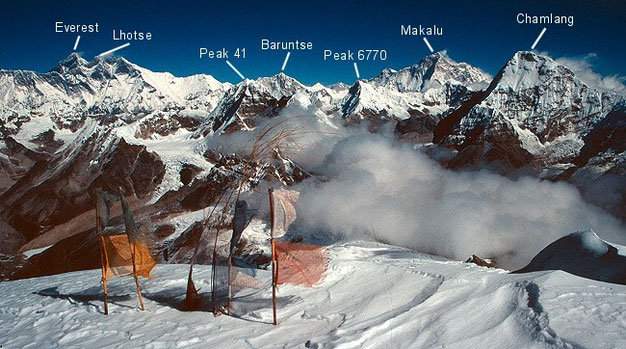
Baruntse
This 7129m (23389 ft) mountain is situated in Nepal between Everest and Makalu. Baruntse, a substantial and symetrical snow peak, has four ridges and four summits. It is bounded on the east by the Barun Glacier flowing north-south from Cho Polu, to the north-west by the Imja glacier and the Hunku glacier forms the south-east boundary. The three main ridges of Baruntse are situated between these glaciers and form an upturned 'Y'running from Cho Polu (6695m) in the north past the Humni La, on to the north summit where it divides. Other well -known mountains in this area are Makalu, Lhotse, Chamlang, Everest and the trekking-peak Mera Peak
Baruntse was first climbed in 30 May 1954 by Colin Todd, Geoff Harrow of the Hilary New Zealand Expedition. They have climbed the mountain by the South -East Ridge. Since than many climbers have used this route and got succeeded.
The south -East Ridge of Baruntse is a straightforward climb, mainly on snow but at high altitudes and crossing some steep sections of ice at 60°, with a prominent ice cliff at about 7,000 metres to be climbed on the way to the top. Sections of the upper summit ridge can be corniced and hold several crevasses, but there is little evidence of avalanche risk on the lower slopes of the mountain. The most successful ascents have been made in the autumn when snow conditions have been good and the mountain has been found to be objectively safe at this time. The steeper sections of the climb are safeguarded by fixed rope, as are the obvious cornices that need to be traversed between the camps on the mountain.
Itinerary planning
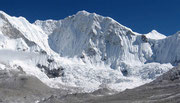
Day 0 - 11 Oct 2011 Leave home.
Day 1 - 12 Oct 2011 Arrive Kathmandu (1,300 meters/4,250 feet). Hotel;
Day 2 - 13 Oct 2011 Orientation day in Kathmandu. Hotel;
Day 3 - 14 Oct 2011 Fly to Lukla (2860 metres/9,400 feet);
Day 4 - 15 Oct 2011 Trek from Lukla to Chutanga (3474 metres/11,400 feet);
Day 5 - 16 0ct 2011 Trek across the Zetrawa La pass (4600 metres/15,100 feet), to the village of Chatra La (Tuli Kharka) (4200 metres/13,800 feet);
Day 6 - 17 Oct 2011 Walk to Kothey (Tashing Ongma) at 3500 metres/11,500 feet;
Day 7 - 18 Oct 2011 Continue to Tagnag at 4300 metres/14,100 feet;
Day 8 - 19 Oct 2011 Rest day, acclimatization, explore the surrounding area;
Day 9 - 20 Oct 2011 Walk to Khare at 5000 metres/16,400 feet, organize equipment;
Day 10 - 21 Oct 2011 Trek across the Mera La, which is at about 5300 metres/17,400 feet to Mera Peak basecamp at 5100 metres/16,700 feet;
Day 11 - 22 Oct 2011 Rest day, acclimatization, explore the surrounding area;
Day 12 - 23 Oct 2011 Climb to High Camp, (5768 metres/18,978 feet);
Day 13 - 24 Oct 2011 Summit Mera Peak (6476 metres/21,246 feet), descend back basecamp;
Day 14 - 25 Oct 2011 Extra day for summit attempt and packing up, resting;
Day 15 - 26 Oct 2011 Trek to Rato Oral (4683 metres/15,360 feet) on the Hongku Khola, which is the main river that flows from Baruntse;
Day 16 - 27 Oct 2011 Trek to Pokhri (5003 metres/16,409 feet);
Day 17 - 28 Oct 2011 Walk to Baruntse basecamp (5300 metres/17,400 feet);
Day 18 - 29 Oct 2011 Rest & Acclimatization, training, and organization at basecamp;
Day 19 - 30 Oct 2011 Rest in basecamp;
Day 20 - 31 Oct 2011 Climb to camp 1 (6120 metres/20,100 feet);
Day 21 - 1 Nov 2011 Rest day in camp 1;
Day 22 - 2 Nov 2011 Climb to camp 2 at 6400 metres/21,000 feet;
Day 23 - 3 Nov 2011 Summit attempt (7129 metres/23,390 feet);
Day 24 - 4 Nov 2011 Extra day for summit attempt, return to basecamp, resting;
Day 25 - 5 Nov 2011 Extra day for summit attempt, return to basecamp, resting;
Day 26 - 6 Nov 2011 Extra day for summit attempt, return to basecamp, resting;
Day 27 - 7 Nov 2011 Pack and prepare to depart basecamp;
Day 28 - 8 Nov 2011 Hike to Panch Pokhri at the base of Amphu Labtsa pass;
Day 29 - 9 Nov 2011 Cross Amphu Labtsa pass to to Chhukhung;
Day 30 - 10 Nov 2011 Walk to Namche Bazar (3450 metres/11,300 feet). Teahouse or camping;
Day 31 - 11 Nov 2011 Trek to Lukla. Teahouse or camping;
Day 32 - 12 Nov 2011 Flight to Kathmandu. Hotel;
Day 33 - 13 Nov 2011 Extra day in Kathmandu, in case of delay, and for sightseeing, gift shopping, celebration, saying goodbye to new friends. Hotel;
Day 34 - 14 Nov 2011 Extra day in Kathmandu, for sightseeing, gift shopping, celebration, saying goodbye to new friends. Hotel
Day 35 - 15 Nov 2011 Fly home.
Day 36 - 16 Nov 2011 Arrive home.
Dispatches
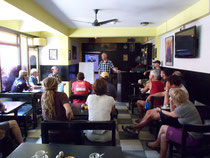
13 october 2011
It is the first few day of our second round of autumn climbing and walking this autumn. We are in Kathmandu and all of the members have arrived. Today is the big team briefing at the Kohinoor Hotel. It has been sunny and pleasant here in Kathmandu, which is good as it keeps excited to get to the mountains. If all goes well, we plan to fly to Lukla on 14 October.
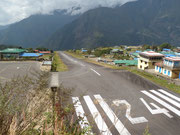
14 october 2011
This morning it was an early and slow start. We left our hotel around 5:30 am to go to the airport for our Lukla flight. Lukla is a small, but busy mountain village at the Everest trail. Many tourists start their mountain adventures here. It has a tiny airstrip on the hillside and the flight specially the landing can be very exciting.
The problem is that they only fly when there is good visibility. This morning started off foggy, so we had to wait a couple off hour's at the Kathmandu airport before we finally could fly to Lukla. After this everything when smooth.
Kaji our Sirdar, already arranged the porters we need for our trek. We had lunch and moved on to our first camping place just below Chutanga at around 3200m a couple of hours walking from Lukla. Here we pitched our tents and have our first night out in the mountain.
Tomorrow we will move on to Yak Kaharka at 4000m, this way we can split the altitude jump over the Zetra la pass in two.
All members are fine and healthy; we are all eager to go to higher elevation.

15 october 2011
Last night we had our first night in tents, from now on these will be our homes. After a good breakfast we headed up to Charkateng just a few hours walk. The trail goes up fairly steep and we walked in the clouds most off the time. Charkateng is located at around 4000m, just before the Zetra La pass. Tomorrow we will cross the pass and walk into a new valley until we reach Mera Peak. It was just a short walk today, so I don't have much news.
We are having an easy start, so we can save energy for later!
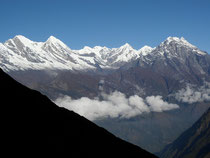
16 october 2011
In the night Charkateng cleared up and we got treated with clear views in the morning. Our staff woke us up at 6:30 am with tea and coffee. We packed our duffles and as soon as our porters got a hold off these, they were already on their way! These people are amazing carrying 30-50kg on their backs, very essential for a successful expedition.
Today we had a clear view of our caravan of porters, because the route goes straight up the Zetra La. I think the group is strong; we all made it up to the pass in a few hours. We had great views of Cho Oyu, the mountain we summitted with our other expedition team just 13 day before. After a small lunch break we descended down to the small settlement of Zetra where we will spend the night.
Tomorrow we will descend to Kote and we are really in the Hinku valley. The Hinku valley is green and beautiful, I am looking forward to that.

17 october 2011
After another early start we hiked to Kote. In the beginning the rout zig zags along the hillside from Zetra, before it drops down to the forest. Before dropping down we got our first view of our objective, Mera Peak. Although this peak is known as a 'trekking peak' it's a massif giant at the end of the Hinku valley.
The forests first consists of rhododendron and bamboo trees, but later giant ancient pine trees. The path continues down until reaching the Hinku River. Along side the river is the small village of Kote, a small oasis! Here we also resupply the expedition with fresh vegetables and meats.
Tomorrow we will continue to Tagnag at around 4300 metres.

18 october 2011
As usual, this morning we were woken up by the sherpas serving morning tea. You can hear the sound of the tray with mugs from far away. It's one of the finest moments of the day.
Also as usual it was very nice weather in the morning. Yesterday we had to climb a 'little more' than expected (optimist Arnold called it 'only going down'). We were anxious to experience today's trip from 3500 to 4200m. This time it was not quite as easy, but we had a nice path, gradually ascending along a river with great views. Today and the following days we will make a half turn around Mera Peak before we sprint up to the summit.
Within an hour from the first of our group arriving at Tagnag, everyone was here. We had a rest in the sun, which really felt like we were in some summer resort. We are going to stay here for two nights. Tomorrow we will be acclimatizing, resting, washing, showering - just as one wishes.
Beside that we're a quite a strong group right now and also a group of people that creates a good atmosphere, with animated talks during all meals, from breakfast to dinner. Mostly English is the common language, but sometimes you can hear Finnish, German or Dutch too.
It's a good life here in the mountains. This evening we are even sitting around a warm wood stove!
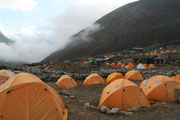
19 october 2011
After a good night of sleep, this morning was a waiting game for the sun. It looked like the sun was playing games with us: everywhere in the valley we could see sunrays, but at our camping spot it seemed a lot longer before it appeared. At around 9am we got rewarded for our patience and we could fully enjoy the warm sunrays.
We spend the morning washing clothes, shower and shaving (for the guys). Some off us went for a small acclimatization hike to a view point nearby.
Tomorrow we will go to Khare at around 5000m. This is the last village along the way to Baruntse. From here we will be all a by ourselves....

20 october 2011
Today started with our morning wake up call with a Sherpa delivering us coffee in bed (or rather in sleeping bag and tent).
We set off at an enthusiastic 8 am for our highest camp to date, Khare, which nestles at the foot of Mera Peak at a respectable 4900 metres. The terrain was more gentle than on previous days and a gradual incline saw us gain 700 metres over the course of between 2 and 3.5 hours.
We saw more of Mera Peak today than we have before as we moved steadily towards the north side, from where we will start our ascent. The mountain afforded us some spectacular views, with the snow drenched peaks rearing through the clouds to tower above us. As we started to pass glacial moraines and vast ice seracs, there was no mistaking the fact that we were now truly in the mountains; the sub tropical vegetation and verdant valleys of past days were far behind us.
On arrival at Khare we were greeted, as always, by Sherpas bearing warm lemon juice and a welcoming smile. Khare boasts a handful of tea houses, an abundance of two man orange tents and several makeshift "facilities". In comparison to some of our previous camps, it's a veritable metropolis.
Lunch was served in a bona fide building - it had windows, stairs and, if you will, floorboards. From this lap of luxury, we will venture forth tomorrow to attempt the Mera-La pass. This snow-covered corridor will perhaps be the group's greatest challenge to date. At 5600 metres, it will be the highest point that some of the group have ever reached. Our crampons and ice axes will be unearthed for the first time as the pass presents us with technical challenges and leads us, as we descend, to Mera Peak base camp.

21 october 2011
Today we woke up with a fresh amount off snow, all night it had been snowing and it didn't look like if it would stop soon. So I decided to stay in Khare and not cross the Mera La today. Specially for our porters who don't have the same equipment as us this would be a bit risky!
Now it looks like the weather is clearing, so tomorrow will probably be fine and we will cross the Mera La to our basecamp at the other side.

22 october 2011
After a snowy day yesterday, today started off sunny and nice. Although the trail was covered with a couple of centimetres of fresh snow, walking wasn't too difficult. The route follows the glacier moraine until you hit the snow cover on the pass. From here you have to climb a little steeper on top of the snowpack, but once you're on top, the route is kind off straight and flat until the pass drops down again.
The surroundings are beautiful; it's a playing arena for mountaineers! We also get a good view on our route on Mera Peak.
Unfortunately the day ended with snow again, this is quite normal in the afternoon. The clouds always drop down and give a little precipitation, but not too much. We passed the last villages until after Baruntse. We have our own kitchen setup, dinning, shower tent, toilet etc. totally self supported from now on!
Tomorrow we will do a day of rope training, before we go higher on the mountain.

23 october 2011
This morning the sunshine on my tent woke me up! Our Mera peak base camp is really at a good spot.Nobody here, only us!
After breakfast we left for the glacier nearby to do some rope training. Our Sherpa's went ahead to fix some ropes on a nice icewall. We practiced cramponing, jumaring, rappelling etc. For the first day since he beginning of our trip we had a full day off sunshine, but high up on the mauntain it looks still very windy.
Tomorrow we will climb to Mera high camp at around 5750m and try to summit Mera the next day.

24 october 2011
All members and most sherpa's walked in their own pace to the Mera Peak High Camp, over the snow fields and glacier. The location of this camp is such, that you should not sleepwalk out of your tent. The tents are placed on small ledges, mostly on a different level. Also finding a 'toilet' place might be very risky, on some rock sticking out. But this, I guess, is one of the adventurous things we booked for. As Arnold remarked, Mera Peak is of course lower than the big giants of 8000+ m, but it has a lot of the things you will find there. So an excellent training mountain for Baruntse that we will reach within a week.
Late in the afternoon our really great cook staff made dinner, served in the tents and after that it was off to bed for a short night.

25 october 2011
0.00 h, wake up time. A breakfast was served, and everyone except Erich prepared for the climb. At 1.45 all climbers and climbing sherpa's were ready and we left. Soon the group was split up into smaller groups (there's a variation in climbing speed), all led by a sherpa. As I later heard most of us had a hard time climbing the 800 metres from high camp to the summit. Was it the early time, or the wind that blew snow in our faces?Apart from Andrea (cold feet) everyone reached the summit, after the last 10 m of iceclimbing with a fixed rope.
At about 8.30 all members had reached the summit with astonishing views on the surrounding mountains and a beautiful sunrise. It was hard work but worth while! After taking their belongings from high camp all climbers are now back in base camp. Tomorrow we will leave this camp in the direction of Baruntse base camp, which we hope to reach within two days.


26 october 2011
After the hard efforts of summit day, we were all delighted to hear that it was back to the normal routine this morning - a friendly wake up with a cup of tea at the leisurely hour of 7am! On the bright side, given that an early night had been the order of the day the evening before, this still meant at least 10 hours sleep, something of a luxury after our rather short night at high camp. In truth however, I was woken somewhat earlier by a new dawn chorus - the sound of hacking coughs coming from other tents. The famous Khumbu cough seems to have taken a hold on a number of team members after the strain of climbing Mera.
Still, today was to be a nice relaxing day - a 500m decent down into the Honku valley where, we were assured, the air would be rich with oxygen, the weather would be warm and sunny and we could all expect to sleep well. With these bright thoughts, I got up for breakfast, only to discover that it was cold and windy and, even worse, the porters had already taken down the dining tent ready to leave. Breakfast was therefore to be an alfresco affair - although it was lovely sitting with views of Mera peak, eating porridge and then omelette and chapattis with gloves on proved slightly more difficult than our normal breakfast (its worth noting for any concerned mothers out there that we are eating extremely well on this trip!).
Breakfast over, we set out with various layers of down clothing on, looking generally more like we were heading out for the summit again than going for a short trek to our campsite. To compound the disappointment of the cold weather, in what is becoming something of a pattern, the walk downhill turned out to be typical 'Nepali' down - with more time spent going uphill than going downhill! Fortunately, we were quickly rewarded with some stunning views of our main objective - Baruntse - glistening in the sunshine at the end of the valley. The walk therefore turned into quite a relaxed affair, a gentle pace for our tired muscles and lots of time to take photos along the way as we passed some stunning green lakes on the way down.
Our campsite for today proved to be a small clearing surrounded by boulders down by the river at about 4,800m where we arrived in time to move into our tents (largely already erected by the Sherpas) and then to have a rather nice lunch (we are truly being well looked after). Sadly, the decent to lower altitudes has brought back the afternoon clouds which rolled in rather early during lunch leading to a cold afternoon and sending most people scurrying to their tents to put on yet more down clothing and to hide from the gentle flurries of snow which have started to fall. Apparently Erich (the oldest member of the team whose combination of age and stamina defy belief) who is something of a philosopher in normal circumstances predicted snow today so I may have to pay more attention to his musings in future...
Anyway, I'm now huddled in the newly erected dining tent, playing some cards and drinking endless cups of tea to keep warm. Meanwhile, the porters seem to be having considerably more fun, laughing and even (allegedly) doing backflips through the camp. Apparently they found some 'medicinal' roots near the campsite which might be making them somewhat happier... hopefully Arnold's extensive medical skills won't have to be tested further...

27 october 2011
After dipping briefly into a valley, we spent the day moving up and across lunar landscapes until we came to our camp site. Situated at over 5400m, we are hemmed in on all sides by jagged black rock, ice and snow. Overnight temperatures touched -20 C, with strong winds amplifying this still further. This is an impressive natural environment: utterly desolate and utterly magnificent in its desolation

28 october 2011
Today was a rest day, before we begin moving up the mountain tomorrow. We will be depositing gear and provisions at Camp 1, around 6100m.
The Sherpa held a Puja ceremony this morning, which is customary before beginning a climb. Many of the western climbers participated, placing an object to be used in the climb - ice axe, crampons, boots - on an altar that was made from stones and adorned with Tibetan Buddhist prayer flags. The ceremony was concluded with readings and ritual blessings.
Radiation from the morning sun warmed things up a bit and some were even seen removing their heaviest down clothing. This afternoon we are just relaxing, drinking tea and preparing for tomorrow...it's time to leave our capsules if we dare.


29 october 2011
A few days agao almost everyone of our group, including me, summited the 6476 m high Mera Peak North, our trek continued to the Baruntse base camp in the shadow of the mighty Baruntse. After a well deserved rest day we held a Puja ceremony during which we and our climbing gear were blessed and we asked the Gods for a successful and uneventful climb.
All we did so far was preparation for our Baruntse climb where we got a first go of today. Most of the team did a carry from basecamp at 5300 metres to camp 1 at 6100 metre and then returned to basecamp. The climb mostly consists of a moderate climb with some steeper sections. Only the last part is more difficult, where we had to negotiate the couloir to the west col, a 45 degrees 200 metre high ice wall. It was a nice climb with beautiful views on the surrounding mountains: Ama Dablam, Baruntse, Makalu and the Amphu Lambtsa La which we will have the cross in a few days time.


30 october 2011
Today we are having another well deserved rest day but the what follows depends on a couple of parameters like weather and route fixing. But if everuthing goes as plannes planned then tomorrow 31 Oct we will move to camp 1, 1 Nov camp 2, 2 Nov summit push, 3 Nov back in basecamp. Everyone is doing fine with the altitude. We are now at a stage where our bodies are rapidly adapting to the altitude. To all loved ones, family and friends; I'm doing extremely well, no complaints and I'm hoping to stand on the summit of Baruntse in a few days.


31 octoberber 2011
We set off for our summit push. Unfortunately Alan, Erich and Mikko decided not to join us. I am in Camp 1 at 6100m now with 13 members.
Tonight our first group, Jan, Markus and Richard, will set off at about 2am. They will try to summit direct from Camp 1, all the others will climb to camp 2 tomorrow at 6400m and try to summit the following morning.
So far none of the other teams here reached the summit off Baruntse.
Yesterday our super Sherpa, Jangbu already went up and fixed rope on all the main difficulties of the summit ridge. They returned just a few metres short of the summit, leaving the last part for us to conquer!
So all is well, I hope the weather will stay as good as it is now. Actually it's warmer here in camp 1 then it was is base camp.



01 novembre 2011
Already one day before the official summit day 5 climbers reached the summit of Baruntse. Whereas the main part of the expedition moved from camp I to camp II, the climbers pursued the so called "swiss solution": They started early form camp I and skipped camp II. So they avoided a second night high on the mountain and the foreseeable "traffic jam" at the official summit day. Chief-Sherpa Jangbu, assistant Sherpa Chauwang, Rich (UK), Jan (Holland) and Markus (Switzerland) left Camp I at 2 AM they reached the point where the ridge gets very sharp (approx 6800m). At this point all groups of other expeditions this season gave up and turned back from here. Luckily our Sherpas found a route from here the day before. The sharp ridge provides an excellent ice climbing over several steep ice walls and extremely exposed cornices. At 10.45 the two Sherpas and the three members reached the summit. During 30 Minutes they enjoyed the spectacular view.
Then the descenT with all the abseilings demanded the full attention. At 1.30 the group was welcomed by the colleagues at camp II. Rich and Markus made all the way down to Base camp (4.30 pm) whereas Jan spent one night at camp I. Early in the morning (after a record temperature reading of - 30 degrees in the tent) he continued to Base camp, where he arrived just in time for a big breakfast with porridge, eggs and pan cake.




02 November 2011
Noora, Mia, Tak, Dave, Arnold, Andrew and Steven left camp 2 at one in the morning and one hour later Stef, Daniel and Nawang Sherpa started their ascent to the summit. The night was clear. We enjoyed the variable climb. Jangbu had made excellent work finding the safest way through the crevasses, overhangs and icefalls.
It was a long night but morning broke as some climbers reached the south summit, others were less lucky and lost a lot of time behind a very slow polish climber who had big difficulties negociating the steep ice walls. From the south summit it was still about 90 minutes until the real summit pyramid. At 8:20 Noora, Mia and Jangbu Sherpa had a beautiful view of most of the 8000 peaks in Nepal and Tibet. It was a windy morning so they didn't stay at the summit to long.
On the way down they met Stef at the south summit followed by Tak, Dave, Arnold, Daniel and Steven. It was a really hot afternoon and they had plenty of time to descend to base camp. There we received a warm welcome by the others who summited one day earlier.
Stef and Nawang Sherpa summitted at 11:30 followed by Arnold and Dave. Daniel turned around just 30 meters short of the summit. Weather was really good at the summit and they stayed about an hour enjoying the astonishing views. On the way down they spend another night at camp two.





03 november 2011
Rest day and the whole team is now back in base camp eating and resting. Only 7 of the 16 expedition members made it to the summit.
Tomorrow we continue our trip to Amphu laptsa so we still have some climbing ahead. It has been a long trip and we are all looking forward to the treats in Namche.
Congratulations to :
- Arnold Coster (leader) - Netherlands
- Stef Wolput - Belgium
- David Smith - UK
- Jan Van den Bos - Netherlands
- Markus Staehlin - Switzerland
- Noora Sotaniemi - Finland
- Mia Graeffe - Finland
- Richard Bryars - UK


04 november 2011
Today we left the place that was our home for the last weeks and start our trek back to civilization. But yet we have to move across morene country, over boulders, passed lakes to the foot of the beautiful Amphu Labtsa.




05 november 2011
We enjoyed a spectacular sunset and sunrise from our camp at the base of Amphulabtsa but equally impressive was the trail of climbers, sherpa's and porters climbing over the pass moving in trail like small ants. What should have been an easy day turned out to be hours quite different. On top of the pass was this huge traffic jam. Our expedition was forced to hold as another group moved up the pass using our ropes. But this was all made up by the great views we had over the Imja valley, Everest, Lhotse, Nuptse, Island peak, Ama Dablam, Baruntse, just awesome.
We all had to walk fast to make it by nightfall in camp. Last Night in the wild, tomorrow we'll be in Disneyland.





06 november 2011
We left Pangboche for Namche and all the sights in between. The skies were clear and for a change we could see some surroundings and the famous 6000+ meter peaks all around. To the North you could see Everest, Lhotse and Nuptse and just opposite across the river you have Ama Dablam lurking ominously as ever. On the way it was hard to walk more than 200 meters before you had to stop and just look at the scenery around you. Just amazing I have to say.
Half way through the walk we hit Tengboche and most people did visit the famous monastery that lies there. It is perhaps not the largest nor the grandest Buddhist monastery out there, but the surroundings are hard to match by any other. Despite the monastery, more attention was paid to the much advertized (by Arnold) bakery on top of the Tengboche hill. If you ever crave for sweets like chocolate cake, croissants, mud cake or just a good brew of coffee while walking, this is the place for you. Just imagine the taste of sticky chocolate in your mouth after three weeks of trekking and it will blow your mind. Do not miss this place if you ever come near this part of the world. Tengboche is situated on a hill side of the river and you have to walk quite a bit of uphill to reach it, but it will be worth it.
After we had finished the sweets the route did dip down to the river for the last time of the day. The descent was deep and long, but on the bottom there were waiting perhaps the best pertches. Do have your go with chhang, the local brew made either from millet or rice as this was the case now. With the sun shining and the white tipped mountains all around you hardly can ask for more.
Not all stopped there though, but continued the yet another ascend towards Namche. The route just North to Namche Bazaar is quite taxing allthough it is quit level. What does take your spirit away is the multitude of bends you have and evertime you think Namche is just around the corner, there is a new bend or two to cross. At least it was moderalety level and the road was almost as wide to drive a car on it.
Just before dinner everybody arrived to Namche and our logde, even though some had already spent several hours of taking in Namche's bakeries and coffee shops to get the few breaths of civilization. More than half of us decided to find lodgings with some more features than damp walls of the tents. I can not begrudge them of doing so, as three weeks in a row with the tents can be trying.
No matter where people were lodging, all gathered to a bar. We also met some of the Ama Dablam team here who had been stuck in these premises for five days as the Lulka flights have been delayed. What a fun night we had.


08 november 2011
We are now in the knowledge that we will fly out from Lukla day after tomorrow as the crowd gets cleared out. Today it will be a light walk to a village called Tok Tok and a bit more closer to the grand world out there. Hopefully in two days we'll be back in the fuzz and buzz and Kathmandu

